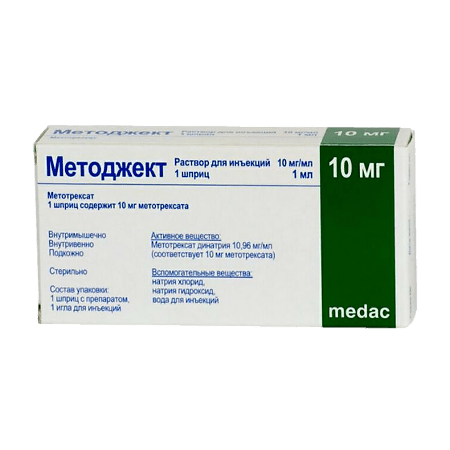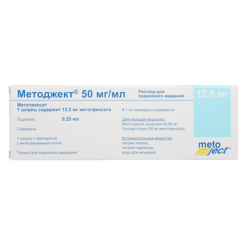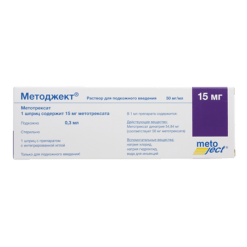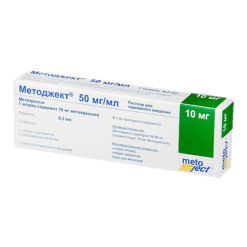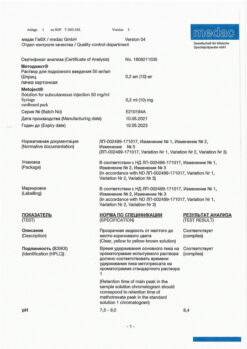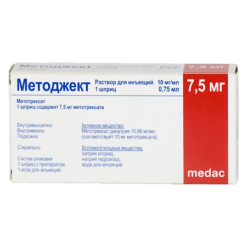No products in the cart.
Description
Pharmacodynamics
Immunosuppressant, antitumor drug, antimetabolite, folic acid antagonist. Competitively inhibits the enzyme dihydrofolate reductase, involved in the reduction of dihydrofolic acid to tetrahydrofolic acid (carrier of carbon fragments required for the synthesis of purine nucleotides and their derivatives). Inhibits synthesis, DNA repair and cellular mitosis.
Methotrexate is especially sensitive to the action of rapidly proliferating cells: cells of malignant tumors, bone marrow, embryonic cells, epithelial cells of mucous membranes. Along with anti-tumor effects it has immunosuppressive effects.
It remains unclear whether methotrexate is effective in the treatment of psoriasis, psoriatic arthritis, and rheumatoid arthritis (including juvenile chronic arthritis): its anti-inflammatory or immunosuppressive effect. It has also not been determined to what extent the effectiveness of therapy is due to the methotrexate-induced increase in extracellular adenosine concentrations at sites of inflammation.
The formation of epithelial skin cells in psoriasis is significantly accelerated compared to normal. The use of methotrexate can slow down the formation of skin epithelial cells, which justifies the use of the drug to treat psoriasis.
Pharmacokinetics
Distribution
The binding to plasma proteins is about 50%.
After distribution in tissues, high concentrations of methotrexate in the form of polyglutamates are found in the liver, kidneys and especially in the spleen, where methotrexate may be retained for several weeks or even months.
When used in low doses, it penetrates the cerebrospinal fluid only in minimal amounts.
Metabolism
About 10% of the administered dose is metabolized in the liver; the main metabolite, 7-hydroxymethotrexate, also has some pharmacological activity. About 5-20% of methotrexate and 1-5% of 7-hydroxymethotrexate are excreted in the bile (with subsequent reabsorption in the intestine).
The T1/2 averages 6-7 h and is highly variable (3-17 h).
Extracted mainly unchanged by kidneys by glomerular filtration and tubular secretion. About 5-20% of methotrexate and 1-5% of 7-hydroxymethotrexate is excreted in the bile (with subsequent reabsorption in the intestine).
Pharmacokinetics in special clinical cases
The T1/2 may increase to values up to 4 times the mean values in patients with additional volume of distribution (presence of pleural effusion, ascites).
The drug excretion in patients with impaired renal function is significantly delayed. There are no data on delayed excretion of methotrexate in patients with impaired hepatic function.
Indications
Indications
Active ingredient
Active ingredient
Composition
Composition
1 syringe contains:
Active ingredients:
Methotrexate disodium 10.96 mg, which corresponds to a methotrexate content of 10 mg.
Excipients:
Sodium chloride,
sodium hydroxide,
water d/s.
In a colorless glass syringe 1 ml.
In the blister 1 syringe of colorless glass, complete with d/i needle.
There is 1 blister in the carton pack.
How to take, the dosage
How to take, the dosage
Metodect is administered p/k, i/m or i/v.
The injection needle included in the package is only intended for injection of Metodect by injection. For intravenous and intravenous administration, the appropriate needles for these routes of administration must be used.
The drug is used once a week. The total duration of treatment is determined by the doctor individually.
The medication must be prescribed by a physician who has experience using methotrexate and who has knowledge about its properties and effects.
In rheumatoid arthritis, the recommended starting dose for adults is 7.5 mg once weekly in m/v, iv or p/u. Depending on the severity of the disease and tolerability of methotrexate, the dose can be gradually increased to 2.5 mg/week. Maximum dose is 25 mg/week. Therapeutic effect usually develops 4-8 weeks after the start of the drug administration. After achieving the optimal therapeutic effect, dose reduction should be started to the lowest effective maintenance dose. The duration of therapy with the drug may exceed 10 years.
In psoriasis and psoriatic arthritis, a week before the start of treatment, a test dose of 5-10 mg of methotrexate should be administered parenterally to detect intolerance reactions. The recommended initial dose is 7.5 mg once a week, i.m., i.v. or p/k. The dose should be gradually increased. In most cases, the dose should not exceed 25 mg/week, but in any case, the maximum dose is 30 mg/week. The therapeutic effect usually develops in 2-6 weeks after the start of the drug. After the desired response is achieved, the dose should be reduced to the lowest effective maintenance dose.
In patients with renal insufficiency, Metoject should be used with caution. Adjustment of the drug dose depending on the CK value is given in the table.
CK (ml/min)
Dose (% of normal dose)
>50
100%
20-50
50 %
/p>
<20
The use of Matoject is contraindicated
Patients with hepatic impairment: In patients with significant current or history of liver disease, especially caused by alcohol intake, Metoject should be used with great caution. Methotrexate is contraindicated in bilirubin concentrations > 5 mg/dL (85.5 µmol/L).
In elderly patients, Metodect should be used with caution, and downward dose adjustment is often necessary due to age-related decline in liver and kidney function and decreased folate storage in the body.
In children under 16 years of age with polyarthritic form of juvenile chronic arthritis, the recommended dose of methotrexate is 10-15 mg/m2 body surface area per week. In case of insufficient effectiveness of treatment, the dose can be increased up to 20 mg/m2/week. Because of limited data on p/c and IV use in children, the drug should be used in juvenile arthritis by injection.
When switching from oral methotrexate to parenteral use, dose reduction may be required due to differences in bioavailability of the drug with different routes of administration.
The concomitant administration of folic acid medications should be considered during therapy with Metodect in accordance with current standards of care.
Interaction
Interaction
The regular use of alcohol and concomitant use of hepatotoxic drugs with methotrexate increases the risk of hepatotoxicity of methotrexate. Patients using other hepatotoxic drugs (e.g., leflunomide) should be closely monitored. This also applies to cases of concomitant administration of drugs that suppress hematopoiesis, which increases the risk of hematotoxicity of methotrexate. When concomitant administration of leflunomide and methotrexate the risk of pancytopenia and hepatotoxicity increases.
Antibiotics such as penicillins, glycopeptides, ciprofloxacin, cephalothin, and sulfonamides may in some cases decrease renal excretion of methotrexate, which leads to increased plasma concentrations and thus to a risk of hematologic and gastrointestinal toxicity.
Probenecid, weak organic acids (such as “loop” diuretics) and pyrazolone-type drugs (phenylbutazone) reduce excretion of methotrexate and may lead to an increase in its plasma concentration and thus an increase in hematological toxicity.
The risk of increased toxicity occurs when combining methotrexate with NSAIDs (because renal tubular excretion of methotrexate may decrease) or salicylates. Caution is required with these combinations.
. Concomitant use of salicylates, phenylbutazone, phenytoin, sulfonamides, sulfonylurea derivatives, aminobenzoic acid, pyrimethamine or trimethoprim, several antibiotics (penicillin, tetracycline, chloramphenicol), Indirect anticoagulants and hypolipidemic agents (colestyramine) increase toxicity due to displacement of methotrexate from binding to albumin and/or decrease of tubular secretion, which in some cases may cause development of severe toxic effect, sometimes even with lethal outcome.
In case of the use of drugs that can affect the bone marrow (including as a side effect) (e.g., sulfonamides, trimethoprim, sulfamethoxazole, chloramphenicol, pyrimethamine) the possibility of inhibition of hematopoiesis should be considered.
The combination of methotrexate with sulfasalazine may increase the effectiveness of methotrexate and, as a result, increase the side effects associated with inhibition of folic acid synthesis by sulfasalazine. However, these side effects have only been seen in rare isolated cases in a number of studies.
Concomitant administration of proton pump inhibitors (omeprazole, pantoprazole) may alter excretion of methotrexate. Concomitant use of methotrexate and omeprazole increases the elimination time of methotrexate. One case of decreased excretion of methotrexate metabolite, 7-hydroxymethotrexate, accompanied by myalgia and shivering has been reported.
When treating with methotrexate, large amounts of caffeine-containing (including coffee, tea) and theophylline-containing drinks should be avoided. Methotrexate reduces theophylline clearance.
The concomitant administration of drugs that can inhibit medullary hematopoiesis (e.g., sulfonamides, trimethoprim, sulfamethoxazole) may lead to increased toxicity of methotrexate. Therefore, extreme caution is recommended when prescribing these drugs to avoid folic acid deficiency.
Folate-containing drugs (including multivitamins) decrease the toxic effects of methotrexate on bone marrow.
Methotrexate increases anticoagulant activity of coumarin or indandion derivatives and/or increases the risk of bleeding by reducing the synthesis in the liver of procoagulant factors and impairment of platelet formation.
When treating patients with concomitant hyperuricemia and gout it may be necessary to adjust the dose of antipodagric agents (allopurinol, colchicine, sulfinpyrazone).
The administration of anesthesia with dinitrogen oxide may result in the development of unpredictable severe myelosuppression and stomatitis.
A few psoriasis patients treated with methotrexate in combination with PUVA therapy (methoxalen and ultraviolet irradiation) have been found to have skin cancer.
Methotrexate can decrease the immune response to vaccination, so the interval between methotrexate and the administration of live and inactivated viral vaccines should be at least 3 months, possibly up to 12 months (depending on the patient’s immune status).
Pharmaceutical incompatibility
Compatibility with other parenterally administered drugs has not been studied.
Methodeject should not be mixed with other drugs and solvents.
Special Instructions
Special Instructions
Patients should be clearly informed that the drug should be used once a week, not daily.
Methotrexate is cytotoxic, so care must be taken in its handling.
Methotrexate-treated patients should be monitored appropriately so that signs of possible toxic effects and adverse reactions are detected and evaluated with minimal delay.
In view of the possible development of severe, or even fatal, adverse reactions, patients should be fully informed by their physician of the possible risks and recommended safety precautions.
Recommended investigations and safety precautions
Before starting or resuming treatment with methotrexate, a complete blood count with platelet count; a biochemical blood count to determine liver enzyme activity, bilirubin concentration, serum albumin; a chest x-ray; and a renal function study. If necessary, conduct tests for tuberculosis and hepatitis.
During treatment (at least once a month for the first 6 months of treatment, then at least once every 2 months) the following tests should be performed:
1. Examination of the oral and pharyngeal mucosa.
2. Complete blood count with determination of platelet count. Methotrexate-induced suppression of hematopoiesis may occur suddenly, including when using the drug in low doses. In any case of a significant decrease of leukocyte or platelet counts, it is necessary to interrupt treatment with methotrexate immediately and provide adequate maintenance therapy. Patients should be advised to report any signs and symptoms of possible infections. Patients who receive concomitant medications that inhibit hematopoiesis (e.g., leflunomide) require close monitoring with monitoring of blood counts and platelet counts.
3. liver function tests. Particular attention should be paid to detect possible toxic effects on the liver. Treatment should not be started or interrupted if liver function abnormalities that were present before or developed during treatment are detected during appropriate examinations. Usually abnormalities that developed during treatment return to normal within 2 weeks of discontinuation of methotrexate therapy, after which time treatment may be resumed at the discretion of the treating physician.
When using methotrexate for rheumatoid arthritis, there is no obvious need for a liver biopsy to monitor hepatic toxicity. special consideration should be given to patients with risk factors such as excessive alcohol consumption, persistent elevation of liver enzymes, a history of liver disease, diabetes mellitus, obesity, use of hepatotoxic drugs or drugs affecting hematopoiesis in a past history.
Control of hepatic enzymes in serum: transient 2-3-fold excess of normal values of transaminases was reported in 13-20% of patients. In case of sustained elevation of liver enzymes activity, dose reduction or discontinuation of treatment should be considered.
Because of the toxic effects of the drug on the liver during treatment, patients should refrain from concomitant use of other hepatotoxic drugs except in cases of obvious necessity; alcohol consumption should also be avoided.
In patients using other hepatotoxic agents or agents that suppress hematopoiesis (e.g., leflunomide), the activity of liver enzymes and parameters of the general blood test with determination of platelet count should be monitored closely.
4. monitor renal function and urinalysis. As methotrexate is mainly excreted by kidneys, in case of insufficient renal function increase of methotrexate concentration in plasma is to be expected, which may cause serious undesirable side effects. In cases of possible reduction of renal function (e.g., elderly patients) control examinations should be performed more frequently. This also applies in cases of concomitant administration of drugs that affect the excretion of methotrexate, drugs that may lead to renal damage (e.g., NSAIDs), as well as drugs that may affect the hematopoietic system. Dehydration can also increase the toxicity of methotrexate.
5. examination of the respiratory system. Particular attention should be paid to symptoms of worsening lung function, and appropriate tests should be performed if necessary. Respiratory symptoms (especially dry non-productive cough), nonspecific pneumonitis, occurring during methotrexate therapy may indicate a potentially dangerous disease and require interruption of treatment and thorough examination for diagnosis. Clinical symptoms of methotrexate-induced lung injury are varied, but fever, cough, shortness of breath, and hypoxemia are typical. A chest X-ray is mandatory to rule out the presence of infiltrates or infection. The possibility of respiratory disease caused by methotrexate does not depend on the doses of the drug used.
If the dose of methotrexate is increased, the frequency of investigations must be increased.
Methotrexate affects the immune system and may impair the response to vaccinations and affect immunological test results. Particular caution is required when using the drug in patients with chronic infectious diseases outside the periods of exacerbation (Herpes zoster, tuberculosis, hepatitis B or C) because of the possibility of exacerbation of the disease. Avoidance of immunization is necessary. The interval between the use of methotrexate and administration of live and inactivated virus vaccines should be at least 3 months, possibly up to 12 months (depending on the patient’s immune status).
If diarrhea and ulcerative stomatitis develop, therapy with methotrexate should be stopped.
Should not expose unprotected skin to very long periods of sun exposure or ultraviolet radiation (photosensitization reaction possible).
In patients receiving low doses of methotrexate, malignant lymphoma may develop, in which case treatment should be stopped. If there are no signs of spontaneous regression of lymphoma, cytotoxic therapy is necessary.
When using methotrexate, osteonecrosis and osteoporosis may develop (with an incidence of ⥠1/1000, < 1/100), which increases the risk of fractures.
Has mutagenic activity in vivo and in vitro. Carcinogenicity studies in rodents showed no increase in tumor incidence with methotrexate.
Impact on ability to drive vehicles and other mechanisms requiring high concentration
As methotrexate may affect CNS (feeling of fatigue, dizziness) the patient must refrain from driving and operating machinery during treatment.
Contraindications
Contraindications
With caution: The drug should be used in patients with ascites, dehydration, obstructive gastrointestinal diseases, pleural or peritoneal effusion, with chronic renal failure; parasitic and infectious diseases of viral, fungal or bacterial nature (current or recent, including recent contact with a patient) – herpes simplex, herpes zoster in viremic phase, varicella, measles, amebiasis, strongyloidosis established or suspected (risk of severe generalized disease); in gout (including a history of gout); in the case of gout (including a history of gout).(including in anamnesis) or urate nephrolithiasis (including in anamnesis), infection and inflammation of the oral mucosa, in vomiting and diarrhea (fluid loss due to severe vomiting and diarrhea may lead to increased toxicity of methotrexate), gastric and duodenal ulcer, ulcerative colitis, prior chemo- or radiation therapy, asthenia, in elderly patients.
Side effects
Side effects
The most common side effects of Metodect are reactions from the hematopoietic system and the digestive system.
Determine the frequency of side effects:
Digestive system disorders: very common – stomatitis, dyspepsia, nausea, loss of appetite, increased transaminase activity; common – mouth ulcers, diarrhea; sometimes – enteritis, vomiting, cirrhosis, liver fibrosis and fatty degeneration, hepatotoxicity (acute hepatitis, liver failure); rare – erosive ulcerative lesions of the GI tract; very rare – vomiting with blood admixture, GI bleeding (incl.melena, hematemesis); pancreatitis is possible.
Hematopoietic system: often – leukopenia, anemia (including aplastic), neutropenia, thrombocytopenia; sometimes – pancytopenia; very rarely – agranulocytosis, severe suppression of bone marrow function.
Dermatological reactions: frequent – exanthema, erythema, dermatitis, skin itching; sometimes – photosensitization, alopecia, enlargement of rheumatic nodes, vasculitis, infections caused by Herpes zoster, herpetiform skin rash, urticaria; rare – increased pigmentation; very rare – changes in nail pigmentation, acute paronychia, Stevens-Johnson syndrome, toxic epidermal necrolysis (Lyell syndrome). In the treatment of psoriasis – a burning sensation of the skin, rarely – painful erosive plaques on the skin.
Allergic reactions: various manifestations up to and including anaphylactic shock; allergic vasculitis, fever.
Cardiovascular system disorders: pericarditis, pericardial effusion, pericardial tamponade, decreased BP, thromboembolism (including arterial thrombosis, cerebral thrombosis, deep vein thrombosis, retinal vein thrombosis, thrombophlebitis, pulmonary embolism).
CNS and peripheral nervous system disorders: frequently – headache, fatigue, somnolence; sometimes – dizziness, confusion, depression; very rarely – pain, muscle weakness or paresthesia of extremities, taste disorders (metallic taste), seizures, meningismus, paralysis.
Endocrine system: possibly – diabetes mellitus.
Sensory organs: conjunctivitis; very rare – visual impairment, (including transient blindness); possible – tinnitus.
Respiratory organs: often – interstitial alveolitis/pneumonia, symptoms of potentially serious interstitial pneumonia (dry non-productive cough, dyspnea and fever); sometimes – pharyngitis; rarely – pulmonary fibrosis, pulmonary pneumocystosis, lung failure and bronchial asthma; possible – pleural effusion, nasal bleeding.
Urinary system: sometimes – inflammation and ulceration of the bladder, painful urination, hematuria, hyperuricemia, renal failure; rarely – severe renal failure, oliguria, anuria, azotemia.
Perior genital system disorders: less frequently – vaginal inflammation and ulceration; very rarely – vaginal discharge, loss of libido, impotence, oligospermia, menstrual disorders, infertility.
Muscular system disorders: rare – arthralgia, myalgia, osteoporosis, osteonecrosis, increased risk of fractures; soft tissue necrosis is possible.
Mechanical disorders: increased sweating, hypogammaglobulinemia; rarely – electrolyte balance disorders.
Infections: possibly – life-threatening opportunistic infections (including pneumocystis pneumonia), cytomegalovirus infections (CMV) (including CMV pneumonia), sepsis (including fatal), nocardiasis, histoplasmosis, cryptococcosis, infections caused by Herpes zoster and Herpes simplex (including disseminated), impaired wound healing.
New growths: in isolated cases, the occurrence of lymphoma. In a recent study, methotrexate therapy was not found to increase the incidence of lymphoma.
Local reactions: when administered by injection, burning sensation at the injection site, aseptic abscess formation, destruction of fatty tissue.
The frequency and severity of side effects of treatment with methotrexate depend on the dose and frequency of use. However, severe side effects can also occur with methotrexate at low doses, so it is important that patients receiving methotrexate be monitored regularly at short intervals.
Overdose
Overdose
Symptoms: the toxic effects of methotrexate are mainly manifested in the hematopoietic system.
Treatment: administration of a specific antidote – preparations of folinic acid (if possible immediately) to neutralize the toxic effects of methotrexate. In case of accidental overdose – within the first hour after administration of methotrexate the specific antidote – preparations of folinic acid – should be administered by IV or IM in a dose equal to or greater than the dose of methotrexate. Thereafter, as needed, folinic acid preparations should be continued until methotrexate serum concentrations are below 10-7 mol/L.
In case of significant overdose, to prevent precipitation of methotrexate and/or its metabolites in the renal tubules, hydration of the body and alkalization of the urine are performed, which accelerates excretion of methotrexate. Hemodialysis and peritoneal dialysis do not accelerate methotrexate excretion. The effectiveness of intermittent (periodic) hemodialysis using a high-speed dialysis machine has been reported.
Pregnancy use
Pregnancy use
Methotrexate is contraindicated in pregnancy and during breastfeeding.
Methotrexate affects fertility function and is embryo-, fetotoxic and teratogenic. When used in humans, methotrexate shows teratogenic properties and can cause intrauterine fetal death and congenital malformations.
The limited use in pregnant women (42) has led to an increased incidence (1:14) of malformations (cranial, cardiovascular, limb). In cases where methotrexate therapy was interrupted before fertilization, a normal pregnancy course was observed.
Patients of childbearing age of both sexes and their partners should use reliable contraception during methotrexate treatment and for at least 6 months after it ends.
If pregnancy occurs during methotrexate therapy, the risk of adverse effects on the fetus should be evaluated.
Methotrexate is excreted with breast milk in amounts that are harmful to the baby, so breastfeeding should be stopped before starting methotrexate treatment and abstained for the duration of treatment.
Similarities
Similarities
Additional information
| Weight | 0.026 kg |
|---|---|
| Shelf life | 2 years |
| Conditions of storage | In a dry, light-protected place at a temperature not exceeding 25 °C |
| Manufacturer | Onkotek Pharma Production GmbH, Germany |
| Medication form | solution for injection |
| Brand | Onkotek Pharma Production GmbH |
Other forms…
Related products
Buy Metodect, 10 mg/ml 1ml ( 10 mg) with delivery to USA, UK, Europe and over 120 other countries.

